Allies of World War I

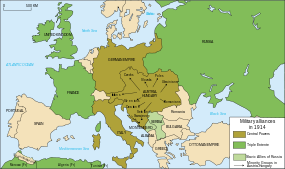
Entente Powers were the countries at war with the Central Powers during World War I. The key members of the Triple Entente were the United Kingdom, France, and the Russian Empire. Many other countries later joined the Entente side in the war: Belgium, Serbia, Italy, Japan, Greece, Romania, and Portugal, which were also drawn into the war.
The United States declared war on Germany on the grounds that Germany violated American neutrality by attacking international shipping and because of the Zimmermann Telegram that was sent to Mexico.[1] The U.S. entered the war as an "associated power", rather than a formal ally of France and Great Britain, because it had not declared war on the Ottoman Empire like those two countries. Although Turkey severed relations with the United States, it did not declare war.
Although the Dominions and Crown Colonies of the British Empire made significant contributions to the Allied war effort, they did not have independent foreign policies during World War I. Operational control of British Empire forces was in the hands of the five-member British War Cabinet (BWC). However, the Dominion governments controlled recruiting, and did remove personnel from front-line duties as they saw fit. From early 1917 the BWC was superseded by the Imperial War Cabinet, which had Dominion representation. The Australian Corps and Canadian Corps were placed for the first time under the command of Australian and Canadian Lieutenant Generals John Monash and Arthur Currie, respectively, who reported in turn to British generals.
In April 1918, operational control of all Entente forces on the Western Front passed to the new supreme commander, Ferdinand Foch.
Contents |
History

The original alliance opposed to the Central Powers was the Triple Entente, which was formed by three Great European Powers:
The war began with the Austrian attack invasion of Serbia on July 28, 1914, in response to the assassination of Archduke Franz Ferdinand. The Austrian Empire followed with an attack on Serbian allies Montenegro on August 8. On the Western Front, the two neutral States of Belgium and Luxembourg were immediately occupied by German troops as part of the German Schliefen Plan. Of the two Low Countries, Luxembourg chose to capitulate, and was viewed as a collaborationist State by the Entente Powers: Luxembourg never became part of the Allies, and only nearly avoided Belgian efforts of annexation, at the conclusion of hostilities in 1919. On August 23, Japan joined the Entente, which then counted seven members.
On May 23, 1915, Italy entered the war on the Entente side and declared war on Austria; previously, Italy had been a member of the Triple Alliance but had remained neutral since the beginning of the conflict. In 1916, two more nations joined the Entente, Portugal and Romania.
The direction of the war changed on April 6, 1917, with the entrance of the United States and its American allies. Liberia, China, Siam and Greece also became allies. After the October Revolution, Russia left the alliance and ended formal involvement in the war, by the signing of the treaty of Brest Litovsk in November effectively creating a separate peace with the Central Powers. This was followed by Romanian cessation of hostilities, however the Balkan State declared war on Central Powers again on November 10, 1918. The Russian withdrawal allowed for the final structure of the alliance, which was based on five Great Powers:
| Population | Land | GDP | |
|---|---|---|---|
| Russian Empire (plus Finland), 1914 | 173.2m (176.4m) | 21.7m km2 (22.1m km2) | $257.7b ($264.3b) |
| French Third Republic (plus colonies), 1914 | 39.8m (88.1m) | 0.5m km2 (11.2m km2) | $138.7b ($170.2b) |
| United Kingdom (plus coloniesand Dominions), 1914 | 46.0m (400.1m) | 0.3m km2 (33m km2) | $226.4b ($334.8b) |
| Empire of Japan (plus colonies), 1914 | 55.1m (74.2m) | 0.4m km2 (0.7m km2) | $76.5b ($92.8b) |
| Kingdom of Italy (plus colonies), 1915 | 35.6m (37.6m) | 0.3m km2 (2.3m 2 ) | $91.3b ($92.6b) |
| United States (plus overseas dependencies),[3] 1917 | 96.5m (106.3m) | 7.8m km2 (9.6m km2) | $511.6b ($522.2b) |
| Allied approximate Total by 1917 | 446.2m | 67.5m km2 | $1,096.5b |
When war finished in November 1918, many new States were formed over the ruins of the Central Powers. The Great Powers recognized these national movements and their help to the common goal, accepting their claims of sovereignty between the signatories of the peace treaties.
Leaders
![]() United Kingdom/British Empire
United Kingdom/British Empire
- George V - King of the United Kingdom and the other Commonwealth Realms, Emperor of India
- H. H. Asquith - Prime Minister of the United Kingdom (Until 5 December 1916)
- D. Lloyd George - Prime Minister of the United Kingdom (From 7 December 1916)
- Horatio Herbert Kitchener - Secretary of State for War (5 August 1914 - 5 June 1916)
- William Robertson - Chief of the Imperial General Staff
- John French - Commander-in-Chief of the British Expeditionary Force (4 August 1914 - 15 December 1915)
- Douglas Haig - Commander-in-Chief of the British Expeditionary Force (15 December 1915 - 11 November 1918)
- Hugh Trenchard, 1st Viscount Trenchard - Commander of Royal Flying Corps - (August 1915 - January 1918)
- "Jackie" Fisher - First Sea Lord - (1914 - May 1915)
- Henry Jackson - First Sea Lord - (May 1915 - November 1916)
- John Jellicoe - First Sea Lord (November 1916 - December 1917)
- Dominion of Canada
-
- Robert Borden - Prime Minister of Canada (1914-1918)
- Sam Hughes- Minister of Militia and Defence (1914- January 1915)
- Joseph Flavelle- Chairmen of Imperial Munitions Board (1915-1919)
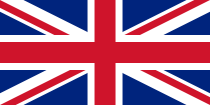 Julian Byng (June 1916 - June 1917) Canadian Corps commander
Julian Byng (June 1916 - June 1917) Canadian Corps commander- Edwin Alderson - Commander of the unified Canadian Corps of the Canadian Expeditionary Force (26 January 1915-September 1915)
- Arthur Currie - Commander of the unified Canadian Corps of the Canadian Expeditionary Force (June 1917 - )[4]
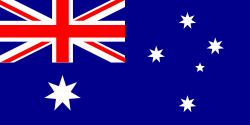 Commonwealth of Australia
Commonwealth of Australia
-
- Andrew Fisher - Prime Minister of Australia (until 27 October 1915)
- Billy Hughes - Prime Minister of Australia (from 27 October 1915)
- John Monash - Commander of the Australian Corps (all five Australian infantry divisions serving on the Western Front) (May 1918 - )
 Indian Empire
Indian Empire
-
- John Nixon commander of the British Indian Army (active in the Middle East)
 Union of South Africa
Union of South Africa
-
- Louis Botha - Prime Minister of South Africa
- Jan Smuts - Led forces in South-West Africa Campaign and East African Campaign, later member of the Imperial War Cabinet
![]() Russia
Russia
- Nicholas II — Russian Emperor, King of Poland, and Grand Duke of Finland. (Until 15 March 1917)
- Grand Duke Nicholas Nikolaevich - Commander-in-chief (1 August 1914 – 5 September 1916) and viceroy in the Caucasus
- Alexander Samsonov - Commander of the Russian Second Army for the invasion of East Prussia (1 August 1914 – 29 August 1914)
- Paul von Rennenkampf - Commander of the Russian First Army for the invasion of East Prussia (1 August 1914 - November 1914)
- Nikolai Ivanov - Commander of the Russian army on the Southwestern Front, (1 August 1914 - March 1916) responsible for much of the action in Galicia
- Aleksei Brusilov - Commander of the South-West Front, then provisional Commander-in-Chief after the Tsar's abdication (February 1917 - August 1917)
- Lavr Georgievich Kornilov - Commander of the South-West Front, then Commander-in-Chief (August 1917)
- Aleksey Kuropatkin - Commander of the Northern Front (October 1915 - 1917)
- Nikolai Yudenich - Commander of the Caucasus (January 1915 - May 1917)
- Andrei Eberhardt - Commander of Black Sea Fleet (1914–1916)
- Aleksandr Kolchak - Commander of Black Sea Fleet (1916–1917)
- Nikolai Essen - Commander of Baltic Fleet (1913 - May 1915)
![]() France
France
- Raymond Poincaré - President of France
- René Viviani - Prime Minister of France (13 June 1914 - 29 October 1915)
- Aristide Briand - Prime Minister of France (29 October 1915 - 20 March 1917)
- Alexandre Ribot - Prime Minister of France (20 March 1917 - 12 September 1917)
- Paul Painlevé - Prime Minister of France (12 September 1917 - 16 November 1917)
- Georges Clemenceau - Prime Minister of France (From 16 November 1917)
- Joseph Joffre - Commander-in-Chief of the French Army (3 August 1914 - 13 December 1916) and Marshal of France
- Robert Nivelle - Commander-in-Chief of the French Army (13 December 1916 - April 1917)
- Philippe Pétain - Commander-in-Chief of the French Army (April 1917 - 26 March 1918) and Marshal of France
- Ferdinand Foch - Commander-in-Chief of the French Army and Marshal of France, Supreme Allied Commander (26 March 1918 - 11 November 1918)
- Milan Rastislav Stefanik - General of French Army, Commander of Czechoslovak Legions
- Georges Thenault - Commander of the Lafayette Escadrille
![]() Serbia
Serbia
- Peter I - King of Serbia
- Vojvoda Radomir Putnik - Chief of the General Staff of the Serbian Army
- Vojvoda Petar Bojović - Commander of First Army, later Chief of General Staff
- Vojvoda Stepa Stepanović - Commander of Second Army
- Vojvoda Živojin Mišić - Commander of 1st Serbian Army
![]() Montenegro
Montenegro
- Nicholas I - King of Montenegro
- Serdar Janko Vukotić - Commander of 1st Serbian Army
![]() Belgium
Belgium
- Albert I of Belgium - King of Belgium (23 December 1909 - 17 February 1934)
![]() Italy
Italy
- Victor Emmanuel III - King of Italy
- Luigi Cadorna - Commander-in-Chief of the Italian army
- Armando Diaz - Chief of General Staff of the Italian army
- Luigi, Duke of Abruzzi - Commander-in-Chief of the Adriatic Fleet of Italy (1914–1917)
- Paolo Thaon di Revel - Admiral of the Royal Italian Navy
![]() Romania
Romania
- Ferdinand I - King of Romania
- Constantin Prezan - Chief of the General Staff of Romania
- Alexandru Averescu - Commander of the Romanian 2nd Army, 3rd Army, then Army Group South
![]() United States
United States
- Woodrow Wilson - President of the United States/Commander-In-Chief of the U.S. armed forces
- Newton D. Baker - U.S. Secretary of War
- John J. Pershing - Commander of the American Expeditionary Force
![]() Japan
Japan
- Emperor Taishō - Emperor of Japan
- Ōkuma Shigenobu - Prime Minister of Japan (16 April 1914 - 9 October 1916)
- Terauchi Masatake - Prime minister of Japan (9 October 1916 - 29 September 1918)
![]() Portugal
Portugal
- Bernardino Machado - President of Portugal
- Afonso Costa - Prime Minister of Portugal
- Norton de Matos - War Minister
- Tamagnini de Abreu - Commander of the Portuguese Expeditionary Corps (CEP)
- Alves Roçadas - Commander of the Portuguese Forces in Southern Angola
- Ferreira Gil - Commander of the Portuguese Forces in Eastern Africa
Personnel and casualties
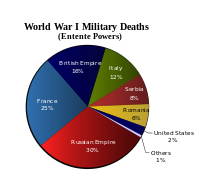
These are estimates of the cumulative number of different personnel in uniform 1914-1918, including army, navy and auxiliary forces. At any one time, the various forces were much smaller. Only a fraction of them were frontline combat troops. The numbers do not reflect the length of time each country was involved. (See also: World War I casualties.)
| Allied powers | Mobilized personnel | Killed in action | Wounded in action | Total casualties | Casualties as % of total mobilized |
|---|---|---|---|---|---|
| Australia | 412,9531 | 61,928[5] | 152,171 | 214,099 | 52% |
| Belgium | 267,0003 | 38,172[6] | 44,686 | 82,858 | 31% |
| Canada | 628,9641 | 64,944[7] | 149,732 | 214,676 | 34% |
| France | 8,410,0003 | 1,397,800[8] | 4,266,000 | 5,663,800 | 67% |
| Greece | 230,0003 | 26,000[9] | 21,000 | 47,000 | 20% |
| India | 1,440,4371 | 74,187[10] | 69,214 | 143,401 | 10% |
| Italy | 5,615,0003 | 651,010[11] | 953,886 | 1,604,896 | 29% |
| Japan | 800,0003 | 415[12] | 907 | 1,322 | <1% |
| Montenegro | 50,0003 | 3,000 | 10,000 | 13,000 | 26% |
| New Zealand | 128,5251 | 18,050[13] | 41,317 | 59,367 | 46% |
| Portugal | 100,0003 | 7,222[14] | 13,751 | 20,973 | 21% |
| Romania | 750,0003 | 250,000[15] | 120,000 | 370,000 | 49% |
| Russia | 12,000,0003 | 1,811,000[16] | 4,950,000 | 6,761,000 | 56% |
| Serbia | 707,3433 | 275,000[17] | 133,148 | 408,148 | 58% |
| South Africa | 136,0701 | 9,463[18] | 12,029 | 21,492 | 16% |
| United Kingdom | 6,211,9222 | 886,342[19] | 1,665,749 | 2,552,091 | 41% |
| United States | 4,355,0003 | 116,708[20] | 205,690 | 322,398 | 7% |
| Total | 42,243,214 | 5,691,241 | 12,809,280 | 18,500,521 | 44% |
Summary of Allied declarations of war on Central Powers
List of the 23 member States of the Entente:
After the Assassination of Franz Ferdinand
.png) Serbia: 28 July 1914
Serbia: 28 July 1914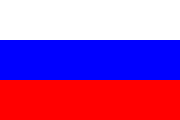 Russia: 1 August 1914 (separate peace in November 1917)
Russia: 1 August 1914 (separate peace in November 1917) France: 3 August 1914
France: 3 August 1914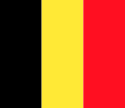 Belgium: 4 August 1914
Belgium: 4 August 1914 British Empire: 4 August 1914
British Empire: 4 August 1914.svg.png) Montenegro: 8 August 1914
Montenegro: 8 August 1914.svg.png) Japan: 23 August 1914
Japan: 23 August 1914
After the Miracle of the Marne
_crowned.svg.png) Italy: 23 May 1915
Italy: 23 May 1915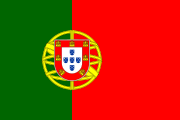 Portugal: 9 March 1916
Portugal: 9 March 1916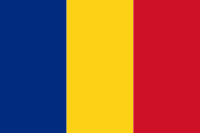 Romania: 27 August 1916 (capitulation in December 1917, returned in November 1918)
Romania: 27 August 1916 (capitulation in December 1917, returned in November 1918)
After the Russian Revolution
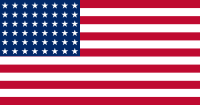 United States: 6 April 1917
United States: 6 April 1917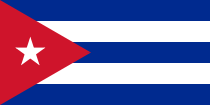 Cuba: 8 April 1917
Cuba: 8 April 1917 Panama: 9 April 1917
Panama: 9 April 1917 Greece: 2 July 1917 (insurgent Movement of National Defence seven months before)
Greece: 2 July 1917 (insurgent Movement of National Defence seven months before)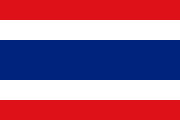 Siam: 22 July 1917
Siam: 22 July 1917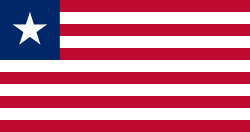 Liberia: 4 August 1917
Liberia: 4 August 1917 Republic of China: 14 August 1917
Republic of China: 14 August 1917.svg.png) Brazil: 27 October 1917
Brazil: 27 October 1917 Guatemala: 25 April 1918
Guatemala: 25 April 1918 Nicaragua: 7 May 1918
Nicaragua: 7 May 1918.svg.png) Costa Rica: 25 May 1918
Costa Rica: 25 May 1918 Honduras: 19 July 1918
Honduras: 19 July 1918.svg.png) Haiti: 25 July 1918
Haiti: 25 July 1918
Special case: British Empire
Five Dominions of the British Empire, which were subordinate to London under international law, were admitted to the Conference of Versailles as reward for their huge military involvement:
- Canada
 Australia
Australia British Raj
British Raj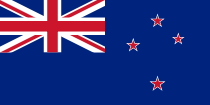 New Zealand
New Zealand Newfoundland
Newfoundland South Africa
South Africa
Special case: Nominal allies
Four States of South America severed relationships with Germany, but did not declare war and had no military involvement:
.svg.png) Bolivia: after April 1917
Bolivia: after April 1917.svg.png) Peru: after October 1917
Peru: after October 1917 Uruguay: after October 1917
Uruguay: after October 1917 Ecuador: after December 1917
Ecuador: after December 1917
Special case: Insurgent nationalities
Four insurgent nationalities, which voluntarily fought with the Allies and seceded from the constituent states of the Central Powers at the end of the war, were allowed to participate as winning nations to the peace treaties:
 Poles
Poles Czechoslovak Legions: armed by France, Italy and Russia
Czechoslovak Legions: armed by France, Italy and Russia The Hejaz: armed by Britain in Arabia
The Hejaz: armed by Britain in Arabia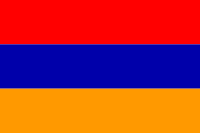 Armenians: seceded from Russia and fought against Turkey
Armenians: seceded from Russia and fought against Turkey
See also
- Triple Entente
- Participants in World War I
- Central Powers
- Allies of World War II
Footnotes
- ↑ US Declaration of War
- ↑ S.N. Broadberry, Mark Harrison. The Economics of World War I. illustrated ed. Cambridge University Press, 2005, pgs. 7-8.
- ↑ As Hawaii and Alaska were not yet U.S. states, they are included in the parenthetical figures.
- ↑ first Canadian to attain the rank of full general
- ↑ Australia casualties
Included in total are 55,000 killed or missing in action and died of wounds6,85-.
The Commonwealth War Graves Commission Annual Report 2005-2006 is the source of total military dead.4-
Totals include 2,005 military deaths during 1919-215-. The 1922 War Office report listed 59,330 Army war dead1,237. - ↑ Belgium casualties
Included in total are 35,000 killed or missing in action and died of wounds6,85 Figures include 13,716 killed and 24,456 missing up until Nov.11, 1918. "These figures are approximate only, the records being incomplete." 1,352. - ↑ Canada casualties
Included in total are 53,000 killed or missing in action and died of wounds.6,85
The Commonwealth War Graves Commission Annual Report 2005-2006 is the source of total military dead.4
Totals include 3,789 military deaths during 1919-21 and 150 Merchant Navy deaths5-. The losses of Newfoundland are listed separately on this table. The 1922 War Office report listed 56,639 Army war dead1,237. - ↑ France casualties
Included in total are 1,186,000 killed or missing in action and died of wounds6,85. Totals include the deaths of 71,100 French colonial troops. 7,414-Figures include war related military deaths of 28,600 from 11/11/1918 to 6/1/1919.7,414 - ↑ Greece casualties
Jean Bujac in a campaign history of the Greek Army in World War One listed 8,365 combat related deaths and 3,255 missing8,339, The Soviet researcher Boris Urlanis estimated total dead of 26,000 including 15,000 military deaths due disease6,160 - ↑ India casualties
British India included present-day India, Pakistan and Bangladesh.
Included in total are 27,000 killed or missing in action and died of wounds6,85.
The Commonwealth War Graves Commission Annual Report 2005-2006 is the source of total military dead.4
Totals include 15,069 military deaths during 1919-21 and 1,841 Canadian Merchant Navy dead5. The 1922 War Office report listed 64,454 Army war dead1,237 - ↑ Italy casualties
Included in total are 433,000 killed or missing in action and died of wounds6,85
Figures of total military dead are from a 1925 Italian report using official data9. - ↑ War dead figure is from a 1991 history of the Japanese Army10,111.
- ↑ New Zealand casualties
Included in total are 14,000 killed or missing in action and died of wounds6,85.
The Commonwealth War Graves Commission Annual Report 2005-2006 is the source of total military dead.4
Totals include 702 military deaths during 1919-215. The 1922 War Office report listed 16,711 Army war dead1,237. - ↑ Portugal casualties
Figures include the following killed and died of other causes up until Jan.1, 1920; 1,689 in France and 5,332 in Africa. Figures do not include an additional 12,318 listed as missing and POW1,354. - ↑ Romania casualties
Military dead is "The figure reported by the Rumanian Government in reply to a questionnaire from the International Labour Office"6,64. Included in total are 177,000 killed or missing in action and died of wounds6,85. - ↑ Russia casualties
Included in total are 1,451,000 killed or missing in action and died of wounds6,85. The estimate of total Russian military losses was made by the Soviet researcher Boris Urlanis.6,46-57 - ↑ Serbia casualties
Included in total are 165,000 killed or missing in action and died of wounds6,85.The estimate of total combined Serbian and Montenegrin military losses of 278,000 was made by the Soviet researcher Boris Urlanis6,62-64 - ↑ South Africa casualties
Included in total are 5,000 killed or missing in action and died of wounds6,85
The Commonwealth War Graves Commission Annual Report 2005-2006 is the source of total military dead.4
Totals include 380 military deaths during 1919-2115. The 1922 War Office report listed 7,121 Army war dead1,237. - ↑ UK and Crown Colonies casualties
Included in total are 624,000 killed or missing in action and died of wounds6,85.
The Commonwealth War Graves Commission Annual Report 2005-2006 is the source of total military dead.4
Military dead total includes 34,663 deaths during 1919-21 and 13,632 British Merchant Navy deaths5. The 1922 War Office report listed 702,410 war dead for the UK1,237, 507 from "Other colonies"1,237 and the Royal Navy (32,287)1,339.
The British Merchant Navy losses of 14,661 were listed separately 1,339; The 1922 War Office report detailed the deaths of 310 military personnel due to air and sea bombardment of the UK1,674-678. - ↑ United States casualties
Official military war deaths listed by the US Dept. of Defense for the period ending Dec. 31, 1918 are 116,516; which includes 53,402 battle deaths and 63,114 other deaths.[1], The US Coast Guard lost an additional 192 dead 11,481.
References
- ^1 The War Office (2006). Statistics of the military effort of the British Empire during the Great War 1914—1920. Uckfield, East Sussex: Military and Naval Press. ISBN 1847346812. OCLC 137236769.
- ^2 Gilbert Martin (1994). Atlas of World War I. Oxford University Press. ISBN 0195210778. OCLC 233987354.
- ^3 Tucker Spencer C (1999). The European Powers in the First World War: An Encyclopedia. New York: Garland. ISBN 081533351X.
- ^4 The Commonwealth War Graves Commission. "Annual Report 2005-2006" (PDF). http://www.cwgc.org/admin/files/6%20Statistics.pdf.
- ^5 The Commonwealth War Graves Commission. "Debt of Honour Register". http://www.cwgc.org/debt_of_honour.asp?menuid=14.
- ^6 Urlanis Boris (2003). Wars and Population. Honolulu: University Press of the Pacific. OCLC 123124938.
- ^7 Huber Michel (1931) (in French). La population de la France pendant la guerre, avec un appendice sur Les revenus avant et après la guerre. Paris. OCLC 4226464.
- ^8 Bujac Jean Léopold Emile (1930) (in French). Les campagnes de l'armèe Hellènique 1918-1922. Paris: Charles-Lavauzelle. OCLC 10808602.
- ^9 Mortara Giorgio (1925) (in Italian). La Salute pubblica in Italia durante e dopo la Guerra. New Haven, Connecticut: Yale University Press. OCLC 2099099.
- ^10 Harries Merion, Harries Susie (1991). Soldiers of the Sun - The Rise and Fall of the Imperial Japanese Army. Random House. ISBN 0679753036. OCLC 32615324.
- ^11 Clodfelter Michael (2002). Warfare and Armed Conflicts : A Statistical Reference to Casualty and Other Figures, 1500-2000 (2nd ed.). London: McFarland. ISBN 0786412046. OCLC 48066096.
Sources
See List of World War I books
- Ellis, John and Mike Cox. The World War I Databook: The Essential Facts and Figures for All the Combatants (2002)
- Esposito, Vincent J. The West Point Atlas of American Wars: 1900-1918 (1997) despite the title covers entire war; online maps from this atlas
- Falls, Cyril. The Great War (1960), general military history
- Higham, Robin and Dennis E. Showalter, eds. Researching World War I: A Handbook (2003), historiography, stressing military themes
- Pope, Stephen and Wheal, Elizabeth-Anne, eds. The Macmillan Dictionary of the First World War (1995)
- Strachan, Hew. The First World War: Volume I: To Arms (2004)
- Trask, David F. The United States in the Supreme War Council: American War Aims and Inter-Allied Strategy, 1917-1918 (1961)
- Tucker, Spencer, ed. The Encyclopedia of World War I: A Political, Social, and Military History (5 volumes) (2005), online at eBook.com
- Tucker, Spencer, ed. European Powers in the First World War: An Encyclopedia (1999)
|
|||||||||||||||||||||||||||||||||||||||||||||||||||||||||||